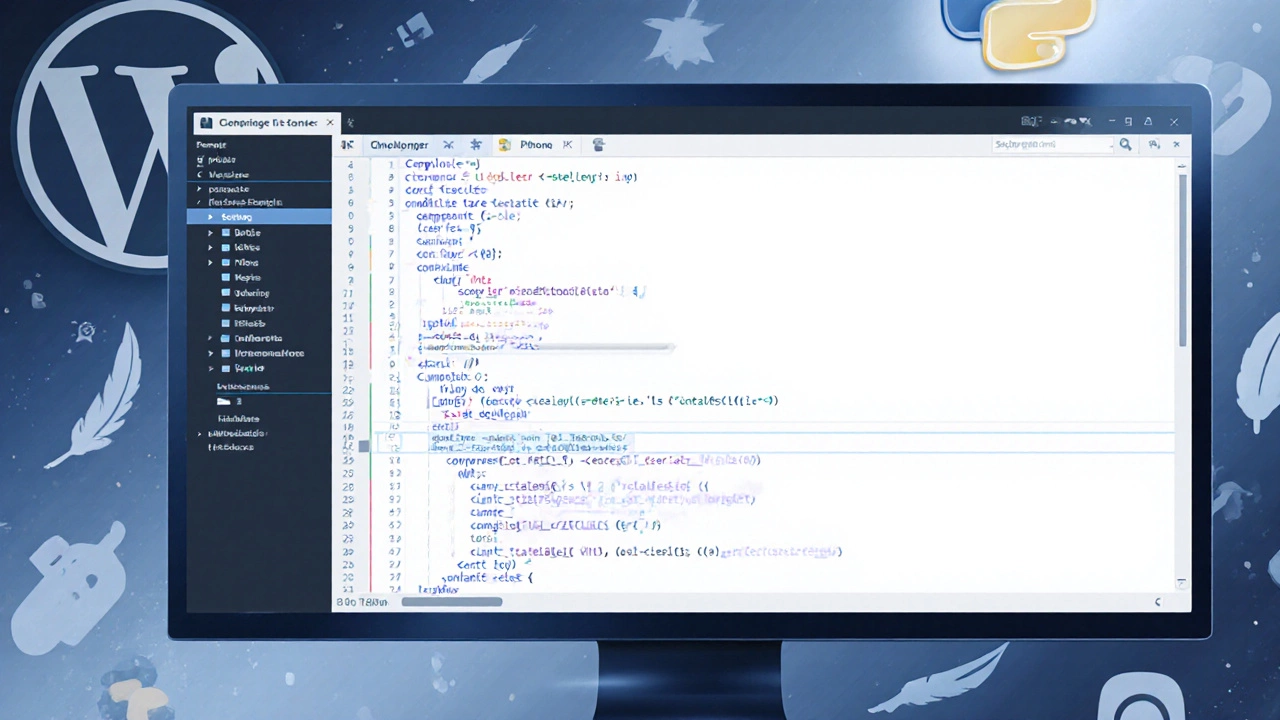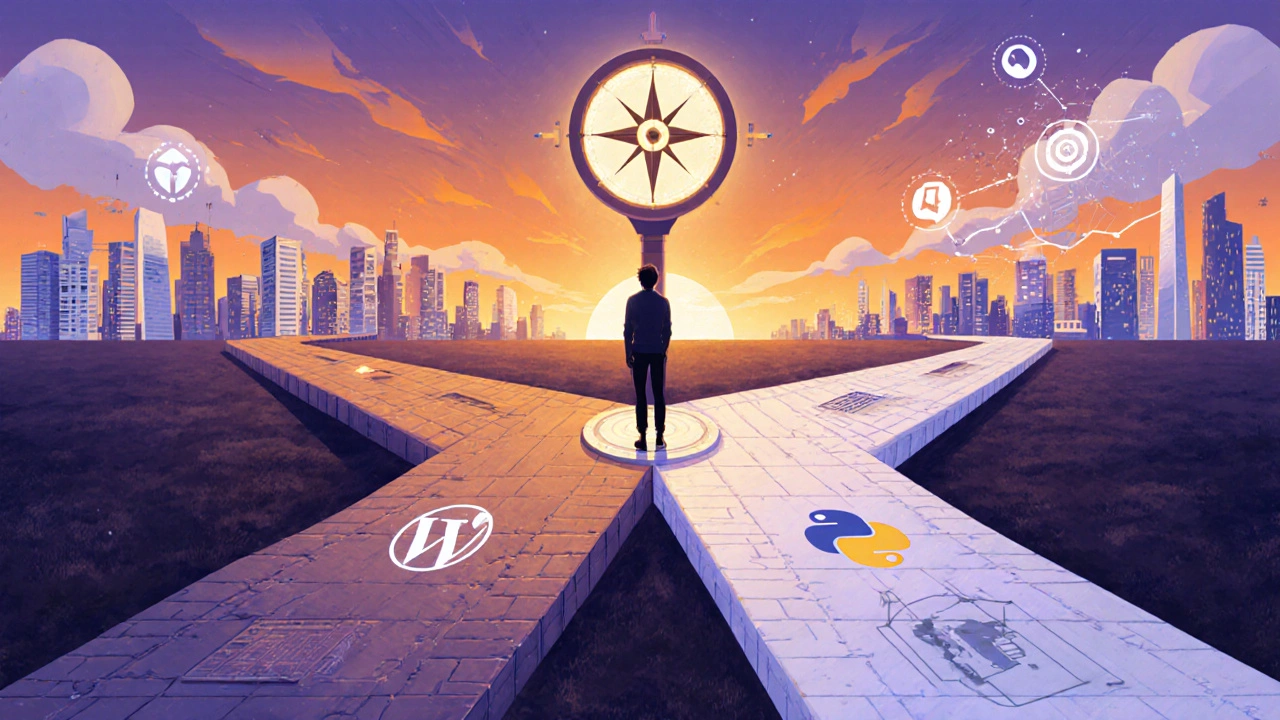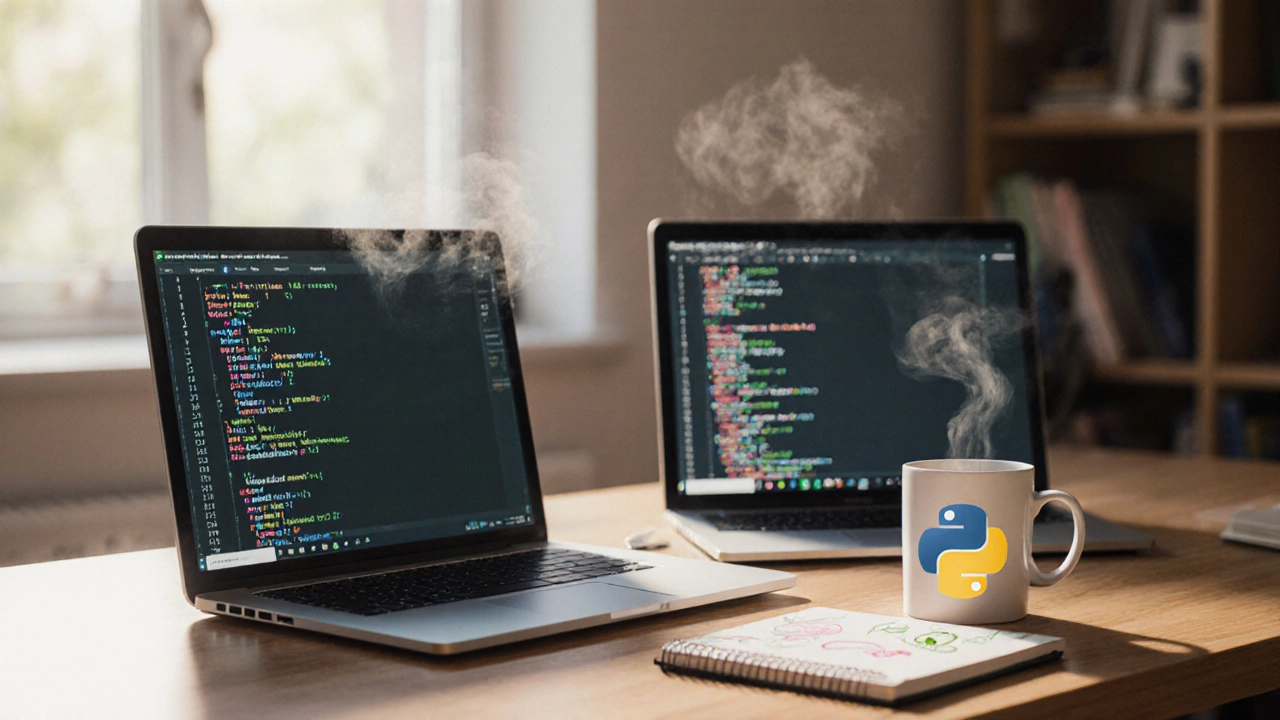PHP vs Python: Which Language Is Easier for Beginners?
Language Recommendation Tool
Which Language is Right for You?
Answer these quick questions to get a personalized recommendation based on your goals and experience.
Your Recommendation
Why this recommendation?
When you start learning to code, the first question often is: PHP or Python? Both claim to be beginner‑friendly, but they serve different ecosystems. If you’re eyeing a career in WordPress development, the answer matters more than you might think.
What is PHP?
PHP is a server‑side scripting language created in 1994 for building dynamic web pages. Over the years it has become the backbone of WordPress, powering roughly 40% of all websites on the internet. Its syntax is loosely based on C, making it easy to embed directly into HTML.
What is Python?
Python is a high‑level, interpreted language designed for readability and broad applicability, from web apps to data science. Released in 1991, it emphasizes clean code with whitespace formatting, which many beginners find less intimidating than curly‑brace languages.
Syntax and Readability
Both languages aim for simplicity, but they take different routes.
- PHP mixes code with HTML using
tags. A typical WordPress theme file can contain HTML markup, a few PHP echo statements, and a loop all in one file. This “all‑in‑one” approach can be convenient for small projects but may feel messy as the codebase grows. - Python enforces indentation as a syntactic rule. There are no closing braces or semicolons at the end of statements, which reduces visual clutter. A simple Flask route looks like:
from flask import Flask app = Flask(__name__) @app.route('/') def home(): return "Hello, world!"
For absolute beginners, Python’s consistent style often feels more intuitive, while PHP’s inline syntax can be a comfortable bridge for those who already know HTML.
Ecosystem and Tooling
Both languages boast mature ecosystems, yet they cater to different niches.
- WordPress is built on PHP. The official documentation (no external links required here) recommends using Composer for dependency management. Composer reads a
composer.jsonfile and pulls in libraries from Packagist. - Python’s flagship web framework is Django. It ships with an ORM, admin panel, and a built‑in server. For package management, Python relies on pip and virtualenv to isolate environments.
- Both languages integrate with MySQL and PostgreSQL for databases, but Python also shines in scientific stacks (NumPy, pandas) while PHP focuses on content‑driven sites.
- Local development stacks differ: PHP developers often use WAMP/LAMP/MAMP bundles, whereas Python users spin up a virtualenv and run
python -m http.serverorflask run.

Performance and Scalability
Performance benchmarks vary by use case, but here are some practical points:
- PHP 8 introduced a Just‑In‑Time (JIT) compiler, narrowing the performance gap with compiled languages. For typical WordPress traffic, PHP can serve thousands of requests per second when paired with opcode caching (OPcache).
- Python’s speed depends heavily on the framework. Flask is lightweight, but Django adds overhead. However, Python excels when paired with asynchronous servers like uvicorn and FastAPI, achieving high concurrency for API workloads.
- Both languages benefit from horizontal scaling via load balancers and container orchestration (Docker, Kubernetes).
Typical Use Cases
Understanding where each language shines helps decide which feels easier for your goals.
- PHP: WordPress plugins/themes, Laravel applications, Drupal, Magento, simple CRUD apps.
- Python: Data analysis, machine learning, automation scripts, Flask/FastAPI APIs, Django sites, scientific computing.
If your target is WordPress development, PHP is the de‑facto choice. If you aim for broader programming horizons-like data science or micro‑services-Python may feel more rewarding.
Learning Curve for Beginners
Let’s break down the first steps a newcomer usually faces.
- Environment Setup
- PHP: Install a local server stack (e.g., XAMPP). Start Apache and MySQL, then place files in
htdocs. A singlephpinfo()call confirms the setup. - Python: Install Python 3.12, then create a virtual environment with
python -m venv env. Activate it and install Flask viapip install flask.
- PHP: Install a local server stack (e.g., XAMPP). Start Apache and MySQL, then place files in
- First “Hello World”
- PHP:
<?php echo "Hello, world!"; ?>embedded in an.phpfile. - Python (Flask):
from flask import Flask app = Flask(__name__) @app.route('/') def hello(): return "Hello, world!" if __name__ == '__main__': app.run(debug=True)
- PHP:
- Community Support
- PHP: Massive WordPress forums, Stack Overflow tags, and official manual.
- Python: Active Reddit, Real Python tutorials, and extensive documentation for scientific libraries.
Both languages have low entry barriers, but Python’s uniform coding standards (PEP8) reduce the chance of “style debates” that sometimes plague PHP newbies.

Which Feels Easier for WordPress Developers?
If you already know HTML, CSS, and a bit of JavaScript, picking up PHP is usually faster because you can edit theme files directly. WordPress provides helper functions (get_posts(), the_permalink()) that hide a lot of boilerplate. You also get a massive library of plugins that you can modify without writing code from scratch.
However, Python can still be useful: writing custom scripts to bulk‑import content, generate SEO reports, or interact with the WordPress REST API. In those cases, Python’s clean syntax can speed up one‑off tasks.
Quick Decision Checklist
| Aspect | PHP | Python |
|---|---|---|
| Syntax Simplicity | Mixes HTML & code; curly braces; semicolons. | Whitespace‑driven; fewer symbols. |
| Setup Complexity | Install LAMP/WAMP; configure php.ini. | Install Python; create virtualenv. |
| Primary Ecosystem | WordPress, Laravel, Magento. | Django, Flask, Data Science. |
| Learning Resources | WordPress Codex, PHP Manual, Laracasts. | Official Docs, Real Python, Automate the Boring Stuff. |
| Job Market (2025) | High demand for WordPress devs, especially SMBs. | Strong in AI, backend APIs, automation. |
| Performance (Typical Web) | Fast with OPcache; optimized for shared hosting. | Good with async frameworks; slower raw CGI. |
Read through the table and ask yourself: “Do I need a CMS‑centric career or a broader programming path?” Your answer will point you to the language that feels easier in practice.
Bottom Line
If WordPress is your target, PHP is the path of least resistance. It lets you dive straight into theme and plugin development without extra layers. If you want a language that reads like plain English and opens doors to data work, automation, and modern APIs, Python is the friendlier choice. Both are beginner‑friendly, but the right one depends on where you want to go.
Frequently Asked Questions
Is PHP still relevant in 2025?
Absolutely. WordPress powers over 40% of the web, and the platform continues to release updates that keep PHP modern. New features like JIT and typed properties mean PHP is more robust than ever.
Can I learn Python and still work on WordPress?
Yes. Python is great for writing scripts that interact with the WordPress REST API, automate migrations, or generate content. It complements PHP rather than replaces it.
Which language has a gentler learning curve for non‑programmers?
Python’s emphasis on readability and minimal punctuation generally feels gentler to absolute beginners. PHP’s tight coupling with HTML can be easier if you already know web markup.
Do I need a local server stack for Python development?
Not necessarily. Python’s built‑in HTTP server lets you run simple apps without Apache or Nginx. For production, though, you’ll likely pair it with a WSGI server like Gunicorn.
Which language offers better job prospects in New Zealand?
Both are in demand. PHP developers are sought after for WordPress agencies in Auckland and Wellington. Python developers see strong demand in fintech, health tech, and AI startups, especially in the Christchurch tech hub.





